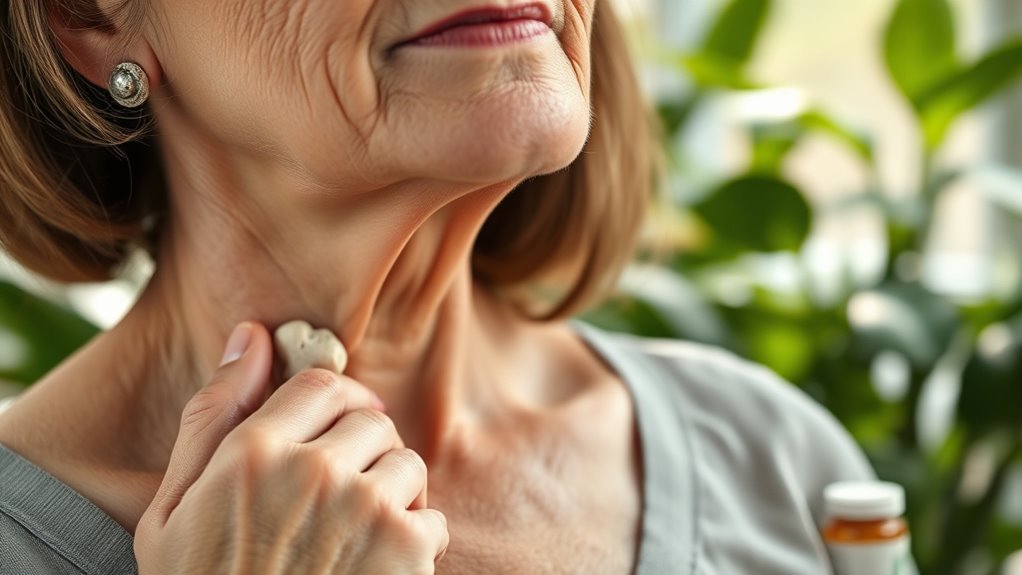To protect your bone health after menopause, focus on a nutrient-rich diet with plenty of calcium, vitamin D, and protein, and stay active with weight-bearing exercises and balance training. Avoid smoking and excessive alcohol, and consider hormone therapy or medications if your risk is high. Regular bone density screenings and fall prevention steps also play a key role. Keep exploring to discover more ways to strengthen your bones during this crucial stage.
Key Takeaways
- Maintain adequate intake of calcium (≥1,000 mg) and vitamin D to support bone mineralization.
- Engage in weight-bearing and resistance exercises to strengthen bones and improve balance.
- Avoid smoking, excessive alcohol, and physical inactivity, which accelerate bone loss.
- Consider hormonal therapy or medications like bisphosphonates under medical supervision to prevent fractures.
- Regularly screen bone density and implement fall prevention strategies to reduce fracture risk.
Understanding the Impact of Menopause on Bone Density

Menopause has a significant impact on your bone density because it causes a rapid decline in estrogen levels, which disrupts the balance between bone formation and resorption. During late perimenopause and early postmenopause, bone loss accelerates considerably, with up to 20% of bone density lost within five to seven years. Estrogen deficiency is the main factor behind this decline, as it normally helps maintain bone health by regulating bone remodeling. The rate of bone loss varies among women, but generally, the spine and hip experience annual decreases of about 1.0% to 2.3% during this period. This rapid decline increases your risk of osteoporosis and fractures, especially if you have low peak bone mass or other risk factors. Recognizing these changes is essential to manage and protect your bone health effectively. Additionally, studies show that optimal angles for pinball machines can enhance gameplay, illustrating how proper adjustments can significantly influence outcomes—paralleling how targeted interventions can improve bone health during menopause. Understanding the role of hormonal changes can help you better adapt your health strategies during this critical time, especially considering how lifestyle factors such as diet and exercise impact bone preservation. Furthermore, emerging AI-powered tools are being developed to monitor and support bone health, offering personalized insights for women during menopause.
Recognizing Key Risk Factors for Osteoporosis

Understanding the factors that increase your risk of osteoporosis helps you take proactive steps to protect your bones. Biological factors like menopause cause a drop in estrogen, which is essential for maintaining bone density. If you’re underweight or have a lean body type, your risk is higher, as bone strength depends partly on body mass. Lifestyle choices also matter: smoking and excessive alcohol consumption weaken bones and accelerate loss. Physical inactivity, especially lacking weight-bearing exercise, contributes to bone deterioration. A family history of osteoporosis increases your vulnerability, and hormonal fluctuations during menopause can speed up bone resorption. Additionally, self watering plant pots are designed to maintain optimal moisture levels, which can serve as a reminder of the importance of proper hydration for overall health. Maintaining adequate nutrient intake is crucial for bone strength, as deficiencies in calcium and vitamin D can significantly increase your risk. Adequate sun exposure helps your body produce vitamin D naturally, supporting bone health. Ensuring sufficient weight-bearing exercise can help promote bone density and reduce the risk of osteoporosis. Incorporating regular health screenings allows for early detection and management of bone density issues, helping you take timely action. Recognizing these risk factors allows you to seek appropriate interventions, such as lifestyle changes or medical advice, to better safeguard your bone health during and after menopause.
Dietary Choices for Stronger Bones

Making smart dietary choices plays a crucial role in strengthening your bones after menopause. Aim for at least 1,000 mg of calcium daily from sources like yogurt, cheddar cheese, dark leafy greens, and calcium-fortified plant-based milks. Legumes such as chickpeas, tofu, and soy products also boost calcium intake. Vitamin D is essential for calcium absorption; include fatty fish like salmon, eggs, and fortified foods or consider supplements, especially since sunlight synthesis decreases with age. Prioritize protein from lean meats, dairy, nuts, and legumes to support bone structure, but avoid excessive consumption. Incorporate magnesium-rich foods like spinach, almonds, and seeds to enhance calcium metabolism. Maintaining balanced nutrition with these nutrients helps preserve bone density and reduces osteoporosis risk after menopause. Additionally, consuming organic fruits and vegetables ensures maximum nutrient retention for overall bone health.
Incorporating Effective Exercise Routines

Incorporating effective exercise routines is essential for maintaining and improving bone health after menopause. Weight-bearing activities like walking and running boost bone density, while resistance training with weights enhances muscle strength and supports bones. High-impact exercises such as jumping can be especially beneficial for older adults, but low-impact options like cycling and swimming are suitable if mobility is limited. Balance exercises, like tai chi, help reduce fall risk. Aim for at least 150 minutes of moderate aerobic activity weekly, with strength training twice a week. Sessions should last 30–60 minutes, gradually increasing intensity. Tailor your routine to your fitness level and health conditions, and always prioritize proper form, warm-up, and hydration. Incorporating weight-bearing exercises can significantly improve bone density and help prevent osteoporosis. Engaging in regular physical activity has been shown to positively influence bone remodeling processes, further supporting bone strength. Consistency is key to optimizing bone benefits and overall strength. Understanding family origins can motivate personalized health strategies and foster a deeper connection to your wellness journey.
The Role of Menopausal Hormone Therapy

Menopause can lead to significant declines in estrogen levels, which accelerates bone loss and increases fracture risk. Menopausal Hormone Therapy (MHT) counteracts this by reducing bone resorption and promoting bone formation. It increases bone mineral density (BMD) and improves bone microarchitecture, making bones stronger and less prone to fractures. MHT is most effective when started soon after menopause, around age 50. It also helps prevent osteopenia and enhances bone quality by improving collagen cross-links. Bone health can be further supported by lifestyle modifications and nutritional strategies. Additionally, recent advances in osteoporosis management have introduced new therapeutic options to complement MHT. While MHT offers substantial benefits for bone health, it’s important to contemplate potential risks and tailor therapy individually. Regular monitoring and combining MHT with lifestyle changes can optimize bone preservation and reduce fracture risk, ensuring better long-term skeletal health after menopause. Incorporating top-rated supplements and weight-bearing exercise can further support bone strength and overall skeletal health. Furthermore, understanding the role of bone turnover markers can help monitor treatment efficacy and guide personalized therapy adjustments. Engaging in self-awareness of health risks can empower women to make informed decisions about their bone health and treatment options.
Pharmacological Options for Bone Preservation

You have several pharmacological options to help preserve your bone health after menopause. Bisphosphonates are effective at reducing fractures, while hormone modulators like SERMs mimic estrogen’s benefits with fewer risks. Additionally, bone formation therapies like teriparatide and romosozumab actively stimulate new bone growth to strengthen your skeleton. For optimal results, combining medication with appropriate lifestyle changes and nutritional support can further enhance bone preservation evidence-based treatments. Incorporating bone density monitoring can help tailor treatment plans for maximum effectiveness. Understanding the role of Gold IRA as a financial strategy may seem unrelated but emphasizes the importance of diversification and proactive planning in overall health and security. Recognizing the significance of Yarn for Scarves in crafting personalized items highlights the value of tailored approaches in health management as well.
Bisphosphonate Effectiveness and Use
Bisphosphonates are widely recognized as an effective pharmacological option for preserving bone density and reducing fracture risk in postmenopausal women with osteoporosis. They work by inhibiting osteoclast activity, which decreases bone resorption and helps maintain bone strength. Available as oral or intravenous treatments, common bisphosphonates include alendronate, risedronate, ibandronate, and zoledronic acid. Their clinical efficacy is well-supported by research showing significant reductions in vertebral and nonvertebral fractures. However, you should be aware of potential side effects like gastrointestinal issues, joint pain, and rare but serious risks such as atypical femoral fractures and osteonecrosis of the jaw. Regular monitoring of bone density and kidney function is important to optimize treatment benefits and minimize risks.
Hormone Modulators Benefits
Hormone modulators, particularly estrogen and its derivatives, offer significant benefits for bone preservation in postmenopausal women. Estrogen helps maintain bone density by reducing bone resorption and encouraging bone formation. When you start hormone therapy early after menopause, it can considerably lower your fracture risk and increase bone mineral density. There are different formulations, including low-dose and non-oral options, which can be tailored to your needs. Combining estrogen with progestogen is recommended if you have an intact uterus to prevent endometrial hyperplasia. Estrogen’s mechanisms include inhibiting osteoclast activity and promoting their apoptosis, thereby reducing bone loss. Additionally, increased awareness of the importance of bone health can motivate women to pursue preventive strategies. Incorporating lifestyle modifications such as adequate calcium and vitamin D intake and weight-bearing exercises can further enhance bone strength. While these therapies are effective, it remains crucial to weigh the benefits against potential risks and work with your healthcare provider to determine the best approach for your health.
Bone Formation Therapies
Bone formation therapies are essential options for maintaining bone health in postmenopausal women at risk of osteoporosis. These treatments help strengthen bones and prevent fractures. Bisphosphonates like alendronate and risedronate are first-line options; they inhibit bone resorption, increasing density but may cause gastrointestinal issues. Denosumab, administered subcutaneously twice a year, also reduces bone loss but requires consistent dosing. Raloxifene prevents vertebral fractures and offers added benefits like breast cancer risk reduction. Here’s a quick visual to compare:
| Therapy | Mechanism | Administration |
|---|---|---|
| Bisphosphonates | Inhibit bone resorption | Weekly or monthly oral doses |
| Denosumab | Blocks bone resorption | Every six months subcutaneously |
| Raloxifene | Reduces vertebral fractures | Daily oral dose |
| Side Effects | GI issues, blood clots | Varies by medication |
| Risks | Osteonecrosis, discontinuation | Requires monitoring |
Essential Screening and Monitoring Strategies

To effectively manage bone health after menopause, you need to understand essential screening and monitoring strategies. Bone Mineral Density (BMD) testing, like the DEXA scan, measures your bone levels in hips, spine, and forearms, helping identify osteoporosis. Women over 65 should undergo universal screening, while those at higher risk—due to family history or low body weight—may start earlier. For women under 65, risk assessments guide whether BMD testing is necessary. Regular follow-up with BMD tests and risk profile updates help track progression or treatment effectiveness. Healthcare providers use clinical tools to evaluate fracture risk, adjusting screening as needed. These strategies enable early detection, personalized care, and timely interventions to protect your bones.
Practical Tips for Fall Prevention and Safety

Falls are a leading cause of injury among women after menopause, but many accidents can be prevented with practical safety measures. You can reduce your risk by taking simple steps at home and in daily routines.
Here are three key tips:
- Improve your environment: Remove tripping hazards, secure furniture, and install good lighting and nightlights to illuminate dark areas.
- Enhance your balance: Practice balance and coordination exercises regularly to strengthen stability.
- Choose proper footwear: Wear shoes with good traction and support to prevent slips and falls.
Additionally, get regular vision checks, review medications for side effects, and use non-slip mats in wet areas. These actions can markedly lower your fall risk and keep you safe.
Frequently Asked Questions
How Does Genetics Influence My Risk of Osteoporosis After Menopause?
Your genetics play a big role in your osteoporosis risk after menopause. Polymorphisms in genes like ESR1, ESR2, LRP5, and WNT16 influence your bone mineral density and fracture susceptibility. If you have certain genetic variants, you’re more likely to develop osteoporosis. While you can’t change your genetics, understanding your genetic risk helps you take proactive steps, like lifestyle changes and regular bone density tests, to protect your bone health.
Are There Natural Supplements That Effectively Strengthen Bones?
You might wonder if natural supplements can strengthen your bones. Soy isoflavones are promising, as they can boost bone density and reduce bone breakdown. Calcium and vitamin D are essential for maintaining bone strength and preventing loss. Botanicals from European and Chinese plants are also being studied for their potential benefits. While these natural options show promise, it’s wise to consult your healthcare provider for personalized advice and to guarantee safety and effectiveness.
Can Certain Medications Worsen Bone Loss During Menopause?
Certain medications can worsen bone loss during menopause. If you take glucocorticoids like prednisone, they decrease bone formation, increasing osteoporosis risk. Thiazolidinediones for diabetes, SSRIs, anticonvulsants, and long-term PPI use can also contribute to bone weakening. These drugs often increase bone resorption or reduce formation. To minimize risks, keep regular check-ups, discuss medication side effects with your doctor, and consider lifestyle changes to support bone health.
What Are the Long-Term Effects of Menopausal Hormone Therapy?
So, you’re curious about the long-term effects of menopausal hormone therapy? Well, it’s a bit like a double-edged sword—offering benefits like better bone health, reduced hot flashes, and improved quality of life, but with risks lurking in the shadows, such as breast cancer, heart issues, and blood clots. You need to weigh these carefully, monitor regularly, and personalize your approach to maximize benefits and minimize dangers.
How Often Should I Have Bone Density Tests After Menopause?
You’re wondering how often to get bone density tests after menopause. Typically, if your initial results are normal, testing every 4 to 8 years is enough unless you have risk factors like family history or low T-scores. If your bone density changes or you’re at higher risk, your doctor might suggest more frequent tests. Insurance usually covers scans every other year for women over 65.
Conclusion
Now that you know how menopause affects your bones, it’s time to take charge. Eat well, stay active, and get regular check-ups—think of it as your personal quest for strength, like a knight guarding a precious treasure. Don’t forget, simple fall prevention tips can save you from a tumble, and hormone therapy might be your Excalibur. Embrace these strategies today, and keep your bones sturdy enough to withstand any storm that comes your way.









